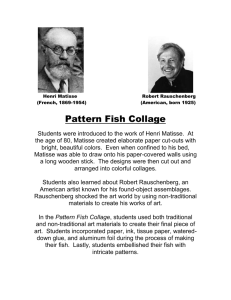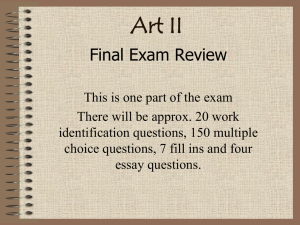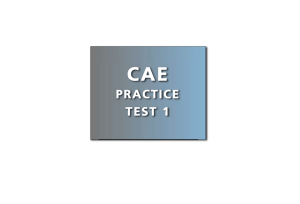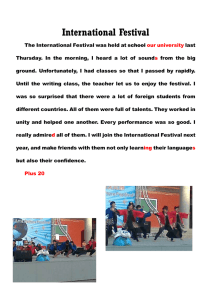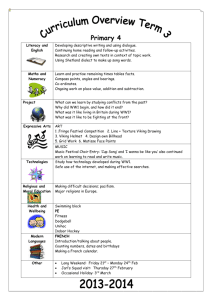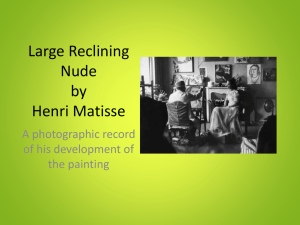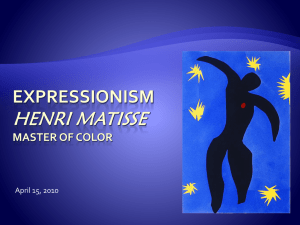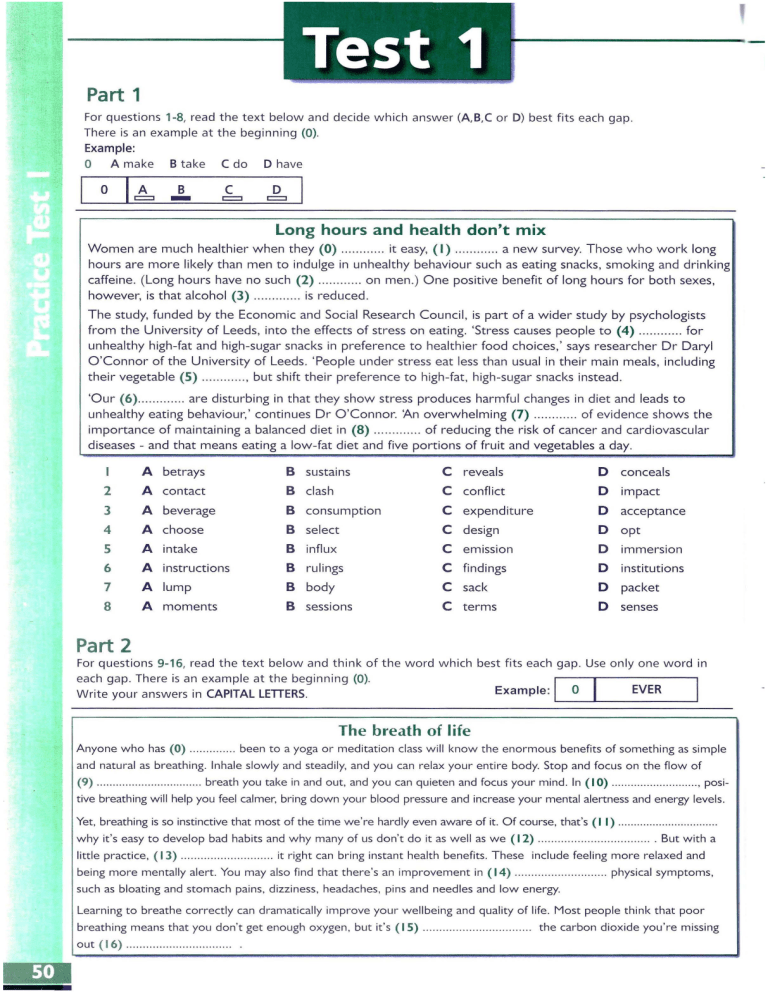
Part 1 For questions 1-8, read the text below and decide which answer (A,B,C or D) best fits each gap . There is an example at the beginning (0). Example: 0 A make B take C do D have 0 I~ B c = D = Long hours and health don't mix Women are much healthier when they (0) .... ..... ... it easy, (I) ............ a new survey. Those who work long hours are more likely than men to indulge in unhealthy behaviour such as eating snacks, smoking and drinking caffeine. (Long hours have no such (2) .... ........ on men .) One positive benefit of long hours for both sexes, however, is that alcohol (3) ............ . is reduced. The study, funded by the Economic and Social Research Council , is part of a wider study by psychologists from the University of Leeds , into the effects of stress on eating. 'Stress causes people to (4) .......... .. for unhealthy high-fat and high-sugar snacks in preference to healthier food choices,' says researcher Dr Daryl O'Connor of the University of Leeds. 'People under str ess eat less than usual in their main meals, including their vegetable (5) ..... ... .. .., but shift their preference to high-fat, high-sugar snacks instead . 'Our (6) .. ...... ..... are disturbing in that they show stress produces harmful changes in diet and leads to unhealthy eating behaviour,' continues Dr O 'Connor. An overwhelming (7) ............ of evidence shows the importance of maintaining a balanced diet in (8) ...... ...... . of reducing the risk of cancer and cardiovascular diseases - and that means eating a low-fat diet and five portions of fruit and vegetables a day. I A betrays B sustains 2 3 4 A contact B clash A beverage B consumption A choose B select 5 A intake B influx 6 A instructions B rulings 7 A lump B body 8 A moments B sessions c c c c c c c c reveals D conceals conflict D expendit ure D acceptance design D opt emission D immersion findings D institutions sack D packet terms D senses impact Part 2 For questions 9- 16, read the text below and think of the word which best fits each gap . Use only one word in each gap. There is an example at the beg inning (0). EVER 0 Example : Write your answers in CAPITAL LETIERS. I The breath of life Anyone who has (0) .... ... ... .. .. been to a yoga or meditation class will know the enor mous benefits of something as simple and natural as breathing. Inhale slowly and steadily, and you can relax your entire body. Stop and focus on the flow of (9) ... ......... ..... .......... .... .. breath you take in and out, and you can quieten and focus your mind. In (I 0) ... ..... ....... .. .... .... .. , positive breathing will help you feel calmer, bring down your blood pressure and increase your mental alertness and energy levels. Yet, breathing is so instinctive that most ofthe time we're hardly even aware of it. Of course, that's (I I) ... ..... ... ... ..... ... .... ..... . why it's easy to develop bad habits and why many of us don't do it as well as we ( 12) .... ... .... ...... ... ...... ...... .. . But with a little practice, ( 13) ........ .......... .......... it right can bring instant health benefits. These include feeling more relaxed and being more mentally alert. You may also find that there's an improvement in ( 14) ... ... ... ..... .. ..... ..... .. physical symptoms, such as bloating and stomach pains, dizziness, headaches, pins and need les and low energy. Learning to breathe correctly can dramatically improve you r wellbeing and quality of life. Most people think that poor breathing means that you don't get enough oxygen, but it's ( 15) ...................... .. ......... the carbon dioxide you're missing out ( 16) ........... ............... ...... . Paper I - Reading and Use of English CAE Practice Test I Part 3 For questions 17-24, read the text below. Use the wo rd given in capitals at th e end of some of the lines to form a word that f its in t he gap in the same line. The re is an example at the begi nning (0). Write your answers in CAPITALLETIERS. Example : 0 SIGNIFICANTLY The cooling oceans The upper layer s of Eart h's oceans have cooled (0) ................. over the past t wo years, even though SIGNIFY the planet as a whole is warming up. Whi le th is may just be part of the nat ural (17) ................................. VARY of oceans, climat ologist s are stil l confounded by the massive unaccountabl e loss of heat. Scienti st s have been (18) ................................... co ncerned by rising sea temperatures over INCREASE the last 50 yea rs but these new (19) ................................. tell a different story. FIND General ly spe aki ng, the (20) ............................. of heat by the oceans red uces atmospheric wa rming. ABSORB Now (21) .................................... taken by the Nati onal Oceanic and Atmospheric Administration have put MEASURE a wrinkle in the trend. The researchers used data from 3000 float ing buoys which monitor the oceans (22) ................................. . WORLD They found that the oceans dropped in temperature by an (23) ...................................... 0.02 degrees BELIEVE centi grade between 20 11 and 2013. Now, that may not seem like much, but trying to account fo r the missing energy is prov ing to be enormously (24) ................................... lt is possible that volcanic eruptions are one main ca use PROBLEM of the phenomenon, but no firm answers have yet been provided. Part 4 For questions 25-30, complete the second sentence so t hat it has a similar mean ing to the first sentence, using th e word given . Do not change the word given . You must use between three an d six words, including the Nord given. Here is an example (0). Example: 0 George should have wo rked harder if he wanted to pass the exam . succeeded Had Geo rge worked harde r, ............ ......... .. ... ..... .... .. ... passing the exam. Write the missing words IN CAPITAL LETTERS. 25 0 I HE WOULD HAVE SUCCEEDED IN Paul tends to play his music loudly when he's not feeling very happy. habit Paul is .......... .... ............... ... ................. ..... . his music loudly when he is not feel ing very happy. 26 They could easily win the game. chance They .............. ... ..... ..... .. ... .... ... ..... ....... .......... ... .... the game . 27 Of course I did not agree to lend them the money. saying it ...... ..... ......... .... ... ..... .................... ........... not agree to lend them the money. 28 Did anything about his behaviour seem unusual to you? strike Did anything about his behaviour ...... ............... .............. ... .... .... ........ ..... .... unusual? 29 I can barely cook a meal for myself, so I certainly couldn't cook for eight people . alone I would struggle .. .... ............ ....... .......... ... ............... .... ......... . for eight people . 30 The reporter said that the blast w as so for ceful that the car was blown right across the street. According to the reporte r, .............................. ....... .. ..... ........... the blast, that the car was blown right across the street. such Paper I - Reading and Use of English CAE Practice Test Part 5 You are going to read a magaz ine article about ident ity theft . For questi ons 31-36, choose t he answer (A, B, C or D) which you think fits best accordi ng to the text. ! 1 I Identity fraud - the new hot crime - Identity theft - cases where thieves steal your personal data to rip through your bank or credit card accounts is a fast-growing crime. Home office statistics estimate a £1.7bn loss over the past 12 months, which, in cash terms, is far ahead of mugging. In the US, where the crime is even more rampant, figures point to a staggering $50bn (about £28bn) a year. The government believes that there are at least 100,000 identity theft victims every year. Others put the figure significantly higher, as some people may not even know their accounts have been raided: identity thieves often stop short of clearing out an account to keep their crime profile low. Identity theft flourishes today because many financial transactions are not face to face. Once criminals get hold of data such as your bank account number and address, they can go on a spending spree. Terrifyingly, they do not need all your details; just a few will do. 'it's easy,' says Glen Hastings, a reformed identity thief and author of Identity Theft, Inc. 'The only prerequisite is the ability to read and write. lt certainly helps to be computer literate, but it's far from essential. I stole several hundred identities in my career.' Hastings' modus operandi was to discover individuals with excellent credit records, the very people banks adore. By impersonating these pillars of financial rectitude, he borrowed large amounts in their name - money that he never, of course, repaid. Even your home could be at risk. Last year, a schoolteacher, who was renting out his unmortgaged Brighton home while he was working in the Far East, was the victim of an audacious identity fraud. A new 'tenant' paid six months' rent in advance but was never to spend a night there, instead, assuming the teacher's identity using documents and items received through the post at the house. The fraudster managed to remortgage the property for £210,000, which he then took out of the country. lt took the unfortunate schoolteacher months of trauma to get his house back. The mortgage company, meanwhile, has never seen a penny of its money back. In the US, one identity victim had her details so closely associated with a $50,000 criminal spending spree that a warrant was put out in her name. The real criminal - who was also a drug dealer - never stopped using the victim's name, even when caught and imprisoned, which led to further problems. Hastings states that he only stole from 'banks, casinos, credit card companies, airlines and ~ big stores - never the little guy.' But we all pay for that, and in any (f ' case, most ID thieves are not so ~"'IDENTY selective. And even 1f you get 'ffiTHEFT your money back - most banks and credit card companies treat victims sympatheticall y · you will still have weeks of worry when you may be unable to acce ss your money and may have to prove that you did not spend £10,000 on internet poker. As an actor, Carol yn Tomkinson is used to taking other people's identities. But when someone impersonated her and cleaned out her Nationwide account, she knew it wasn't play-acting. 'When I found out, I burst into tears,' she says. 'lt was all my money gone overnight. Colleagues clubbed together and lent some cash, but it was awful - I felt stunned, upset and violated.' Carolyn had taken £20 from a cash machine the night before. Somehow - probably with concealed gadgetry to read her PIN and clone the card - thieves took £570 from other machines in London, showing a typical fraud pattern in the way they tested her daily limit, then hit her again just after midnight. 'I discovered it the next day when I wanted to take out a further £20. The machine said I had no further credit available. I then discovered what had happened from the mini-statement. I rang Nationwide, who said they would cancel my card and asked me to report it to the police. The building society was very sympathetic, but said it could take up to six weeks before I got my money back. In the event, it only took a week. 'I've always been very careful, but now I try to avoid ATMs by getting cashback at the supermarket checkout.' Architectural librarian Claudia Mernick has been 'cloned' three times. The third attack was on her credit card. 'I'd been out buying food one lunchtime. Almost as soon as I got home, the credit card company called me to see how I could have used my card in two places that were far from each other, at the same time. lt was an obvious fraud. I was really impressed with their speed. My credit card was cancelled and it took a week or so before I had a new one. But I would like to know what happened and how to avoid it. The thieves didn't cost me a lot of money but a lot of hassle.' \..At: t"ract1ce lest 3 I. 1 Paper I - Reading and Use of English What is said about identity theft in the first two paragraphs? A lt has caused many criminals to stop mugging people. B. Compared to the US, there is not a serious problem in Britain. C. lt can be done so discreetly that the victim is unaware of the crime. D . If an account is not emptied, the victim will probably never realise that they have lost money. 32. According to Glen Hastings A his computer skills made him exceptionally good as an identity thief. B. banks are only willing to lend money to people who already have a lot of money. C. he had always intended to repay the money he borrowed. D. almost anyone is capable of identity theft. 33. What did the tenant who rented a house from a schoolteacher do? A He didn't pay the rent that he'd promised to pay in advance. B. He used the house as security to borrow a large amount of money. C. He sold the house to another individual and then fled the country. D . He pretended to be the schoolteacher and spent all the money in his account. 34. What was the immediate effect of identity theft on Carolyn Tomkinson? A She was shocked . B. She was angry. C. She felt physically ill. D. She pretended to be more upset than she actually was. 35. What was the situation with Carolyn Tomkinson? A Her cash card had been stolen. B. The thieves had used her card too many times on the same day. C. The building society managed to stop her card before the thieves could empty her account. D. Her card had been copied. 36. Claudia Mernick's experience A shows that the finance company is usually to blame. B. proves that vigilance by the credit card company is crucial when it comes to identity fraud. C. illustrates that only the finance company can detect when a card is being used in a fraudulent way. D. proves that finance companies solve identity fraud cases very quickly. CAE Practice Test I Paper - Reading and Use of English Part 6 You are going to read fo ur reviews of an art exhibition . Fo r questions 37-40, choose from reviews A-D . The reviews may be chosen more than once. Matisse Retrospective Four critics comment on an exhibition of the artist Henri Matisse A Midway through the museum's retrospective on c Matisse, I bumped into the painter Alex Katz . He The exhibition at the museum should dispel any doubts about how hard this father of modern art laboured to create the colourful and seemingly insouciant paintings and works on paper that have become so well-known and loved . As the wall texts in the show point out, "Painting did not, and never had, come easily to Matisse. Throughout his career, he constantly hesitated, questioned, repainted and re-evaluated his work. " Today it seems clearer than ever that Matisse was , first and foremost, a supreme colourist . His use of pinks and purples, clarets, oranges and crimsons, is more surprising and electric, than any other European's of that generation . Even when you compare him to that other 20th-century giant Picasso, Matisse wins the colour wars hands down (even Picasso admitted it, once) . Far from the intuitive, child-like genius that some have imagined him to be, Matisse was someone who turned himself into a major artist through years of prodigious effort. In that respect, he's no different from the vast majority of artists th r oughout history. looked at me, agog, and said , " I thought I was going to faint when I saw these paintings ." He gestured at two Matisse still life works from the mid 1940s. Already in a stunned state of my own , I followed his lead and gulped at the revolutionary pictorial power and radical colour radiating off these two powe r houses, one dominated by a celestial red and an arrangement on a table. In the foreground , were either a dog and cat chas ing each other, or a pair of animal-skin rugs . Then I looked at the painting next to it, which also showed Matisse's inherent ability to depict form and colour, with stupendous results . I saw the same still life depicted on the same table with the same vase, goblet, and fruit . But this version was totally different. Where the dog and cat were , there's an ultra flat still life within the still life . it's so categorically compressed that it looks less than twodimensional; maybe, one-half-dimensional. I thought I, like Katz, might pass out. D B The great French modernist painter Henri Matisse was not a joiner. In the early 20th century, he refused to join any of the popular art movements of the time . He communed with artists of the distant or not-so-distant past, from Giotto to Cezanne, and periodically brushed shoulders with Cubism and the work of his chief rival , Pablo Picasso, from Spain . But his main desire was, as he stated , to " push further and deeper into true painting" . His evolution , a result of studied attempts to master his art, is the subject of the exhibition at the museum and one of the most thrillingly instructive shows about this painter, or painting in general, that you may ever see. As ravishing as it is succinct, it skims across this French master's long, productive career with a mere 49 paintings, but nearly all are stellar if not pivotal works . Ravishing colours , flowing lines , sinuous bodies: Henri Matisse made it all look effortless. But it wasn't. Throughout his career Matisse wrestled with the fundamentals of painting; he revisited the same subjects over and over, and he often used completed canvases as models for later ones. Extraordinary insights into his process of creation are laid bare in the eye-opening new exhibition at the museum . The nearly 50 paintings on display reveal how Matisse used older works to generate new ideas. Sometimes the differences are subtle, and sometimes the works are shockingly unalike. But Matisse was using repeated images to push his art further. Later in his career, Matisse hired a photographer to capture his work in the studio. He used photographs of his own paintings to judge whether he was making progress, or whether he'd gone off track. Ultimately, the show reveals Matisse as an artist who made the act of painting into something as important, and as inspiring, as his finished works. Which reviewer unlike the other three reviewers , makes no reference to Matisse's use of colour in his work? 37 disagrees with the other three reviewers , in saying that Matisse's ability was innate? 38 explores some of the techniques Matisse used in his artistic process? 39 makes comparisons between Matisse and a Spanish artist like reviewer B? 40 Paper I - Reading and Use of English CAE Practice Test I Part 7 You are going to read an extract from a magazine article . Choose from the paragraphs A-G the one which fits each gap (41-46 ). There is one extra paragraph which you do not need to use . Bridge under troubled water Sitting at the crossroads of Europe and Asia, the ancient city of Istanbul has seen thousands of years of trade, battles and invasions. Now it is the scene of one of the most audacious engineering projects in the world. Istanbul is divided by the Bosporus strait that connects the Black Sea to the north of the city with the Sea of Marmara to the south. Part of the city lies in Europe, on the western side of the strait, while the rest is in Asia. Recently, a mix of technical expertise, foreign investment and national pride finally came together to make the sultan's dream a reality. This time the plan is not so much to unite an empire as to deliver modern Turks from traffic hell. The plan is first to improve the existing railways on both sides of the strait and then extend them to the coast via tunnels bored through the bedrock. The centre section, under the Bosporus, will be a 1.4-kilometre tube made up of several shorter sections that will be built on land, floated into position and sunk into place. End to end, the tunnel will be 12 kilometres long. The re sult is what geologists refer to as a right-lateral strike-slip fault, similar in size and type to the San Andreas fault in California. The NAF runs for 1600 kilometres across northern Turkey, and the abutting plates move about 2 to 3 centimetres relative to each other every year. Almost every quake along the NAF in the past 100 years seems to have set up a larger one, to the west. The process appears cyclic: quakes march along the fault in sequence until stress falls below a certain threshold, and then start again after a period of quiet. In 1997, geologists studying the most recent cycle predicted that the next shock would hit near the port city of lzmit, 80 kilometres ea st of Istanbul. Sure enough, a major quake of magnitude 7.4 struck close to lzmit in August 1999, followed by another in Duzce in December, together killing over 18,000 people and causing $10 to $25 billion of damage. Recent estimates by the US Geological Survey, the University of Tokyo and Istanbul Technical University estimate that the probability of a strong quake hitting Istanbul is up to 44 per cent in the next decade and as much as 77 per cent in the next 30 years. A major earthquake and accompanying tsunami are considered inevitable within a generation. Paper I - Reading and Use of English CAE Practice Test I A Earthquakes along the NAF are common. In the past seven decades, Turkey has endured seven earthquake s of magnitude 7.0 or greater. While some earthquakes relea se the stress that has built up on a fault, seismologi sts have come to reali se that others simply shift it along the fault , leaving it even more prone to slip. E The crucial factor that lets the tunnel s withstand quakes of this magnitude is the fact that both are "immersed tubes". In this design, engineers dig a channel into the seabed and float the fabricated sections into position above it before sinking them and covering them over. The Marmaray tunnel will use a similar approach. B Two road bridges·cro ss the strait and there are plans for a third, but ever since the Ottoman sultan Abdul Mecit suggested it in 1860, city leaders have dreamed of building a tunnel to link the two halves of the city. F The Marmaray Rail Tube Tunnel, the first stage of which opened on October 29th, 2013, will not only be the deepest underwater tunnel ever constructed. lt will also pass within 16 kilometres of one of the most active geological faults in the world. A major earthquake is not only expected, but also imminent. No wonder the Turki sh government is calling it the project of the century. G lt might sound straightforward, but the project engineers face a major geological hurdle. Twenty kilometres south of Istanbul lies the North Anatolian Fault (NAF), where the Anatolian plate that underlies Turkey, Greece and the north Aegean is being squeezed to the south and south-west by the surrounding Arabian, Eurasia and African plates. c D Seismologists agree that the most recent quakes on the NAF have shifted the stress steadily closer to Istanbul. Now the question isn't if a major earthquake will strike the city, but when. Today, crossing the Bosporus means either a 3-hour trip by rail and ferry, or braving grid lock in narrow, 2000-year-old streets and the two overcrowded road bridges. The Marmaray project, which takes its name from the Sea of Marmara and "ray", the Turkish word for rail, aims to ea se the strain by replacing car traffic with an upgraded rail service that will whisk commuters between Europe and Asia. CAE Practice Test I Paper - Reading and Use of English Part 8 You are going to read some reviews for festivals in the UK. For questions 47-56, choose from the revi ews (A-F). The reviews may be chosen more than once . In which review is the following mentioned? A cheap way to learn how to do an activity. An event opened by young people. Art reflecting life. 47 I 48 1 49 1 Watching a film in the fresh air. I 50 Watching professionals fighting. 51 The chance to make a long-term investment. 52 Someone who did quite well in a competition. 53 Spending time with contemporary literary celebrities. 54 Music in a religious building. People pretending to be dolls. I 55 56 I I I UK Festivals A Brighton The Brighton festival runs from 1st-23rd May this year, and some 300,000 visitors are expected. More than 700 dance, theatre, music, art and literature events will take ol ace throughout the city, ranging from outdoor events .n the Lanes and by the seafront, to theatre and dance .n the Dome auditorium. The festival kicks off on May Day in Sydney Street with the "Children's Classics" oar ade of 4,000 children; they'll be dressed as charac:ers from the books of authors such as one-time Brighton resident Lewis Carroll. Other events include exhibitions and street performances. There will be a special exhibition of work by recent graduates of the niversity of Brighton Fine Art Department. All the work Nill be for sale so it's a good chance to pick up a ootential masterpiece. B Norfolk and Norwich his year's offerings combine tradition with modern events such as a comedy evening. To help warm up for he festival, which runs from May 5th to the 23rd, a :ree street festival will take place on 24th April, with 1uman mannequin window displays at Jarrod's department store, acrobatic skateboarders and life-size garden gnomes. There will also be a beer festival with ver 100 real ales and wine tasting offering a selection of British wines. For those people who are more advenurous there will be the opportunity to have a ride in a not air balloon, weather permitting. There will also be a oook exhibition in the park and special storytelling afternoons for children by some of Britain's leading authors. Or your child can borrow a book and read for himself or herself. c Preston Promoting its status as one of England's newest cities, Preston's International City Festival takes place 11th-20th June. The festival will have an international flavour because this year the Preston Caribbean Festival will be incorporated into the proceedings with a lively carnival and Preston's Asian community will stage dance, art and music events. The festival will have a gastronomic theme, with demonstrations from some of Europe's top chefs and cookery workshops given by the city's Indian and Chinese communities. There will also be a "proms in the park", an open-air cinema in Avenham Park and a street theatre. D Liverpool The Mersey River Festival is the largest maritime event in England this year and will take place around Albert Dock and Pier Head on 18th-21st June. Visiting tall ships will be open to the public. Blue Badge guides will lead tours around uverpool landmarks such as the Cunard building, and voices will unite for the International Sea Shanty festival. Get into the festival spirit by trying out kayaking, water polo and a variety of other water sports for free at the Watersports Centre. If you sign up for a course of watersports lessons which start after the festival, you will receive a 50% discount. There will also be unarmed combat displays by the Royal Marines to raise money for charity, a river parade, an illuminated narrow boat parade through the docks, and an historic diving exhibition. E City of London This year's festival, 21st June - 13th July, celebrates the lOth anniversary of democratic elections in South Africa. Events include a performance by Ladysmith Black Mambazo at St Paul's Cathedral, a varied programme of South African music at the Spitz Club and a range of free dance events in Guildhall Yard. There will also be performances of Beethoven's string quartets by the Borodin Quartet at various concert halls, as well as many other classical offerings, dance, theatre and literary events. There will also be an exhibition of art by local youths. The images all illustrate life in the city of London and provide some interesting insights into how London is viewed by its young inhabitants. F Exeter The summer festival in Devon's principal city takes place 2nd-18th July. Hot tickets are likely to be the audiences with Joan Bakewell and director Ken Russell at the Northcott Theatre and a concert given by Mercury music Prize 2000 nominee Nitin Sawhney. Theatrical offerings include hit comedy Art, directed by Nigel Havers at Escot House, and a world premiere of the English Chamber Theatre's production of Chekov's Leading Lady. The 4th of July will also resound to a Latin beat, with dance performances from the Jaleo Flamenco Dance Company taking place around Exeter Quay. The London Community Gospel Choir, the Brodsky Quartet and the New Berlin Chamber Orchestra will also perform during the festival. CAE Practice Test I Paper 2 - Writing WRITING - Part 1 You must answer this question . Write your answer in 220-260 words in an appropriate style . I. You have listened to a radio discussion programme about which facilities are needed most in your area. You have made the notes below: Which facilities are needed most in your area? • car park • sport centre • history museum Some opinions expressed in the discussion: "Yo un g people need sports fac ilities." "Car parks a re onlrfor people who Oll'n a ca r'" "Museums help to eduwte people." Write an essay discussing two of the facilities in your notes. You should explain which facility is needed most in your area, giving reasons in support of your answer. You may, if you wish, make use of the opinions expressed in the discussion, but you should use your own words as far as possible. WRITING - Part 2 Write an answer to one of the questions 2-4 in this part. Write your answer in 220-260 words in an appropriate style. 2. You have just completed a cooking course. As part of the school's research and efforts to offer superior classes, they have asked you to write an evaluation of your experience as a student. Your report should discuss what you learned from the class and what you thought of the teachers and their instruction methods. Mention any ways you think the class could be improved and say whether you would or would not recommend the course to a friend or relative. W r ite your report. 3. You see this advert in a newspaper: Tour guides needed We need a hard-working team of people to work as tour guides throughout the summer period. A good knowledge of your local area is required, as well as the ability to get on well with people. If you are at lea st 18 years old, write to us and tell us about your character and interests. We would also like you to say what you think is one of the highlights of your area and why. Write a letter applying for the job advertised. You do not need to include postal addresses. 4. You are the arts review writer for a magazine. Your editor has asked you to review a film. Choose a film that you have seen. Describe the plot and the characters involved. Say who the film is suitable for and why. Mention any special effects or aspects of the film that stood out in some way. Would you recommend the film? Why, why not? Write your review. CAE Practice Test I Paper 3 - Listening LISTENING - Part 1 You will hear three different extracts. For questions 1-6, choose the answer (A, B or C) which fits Jest according to what you hear. There are two questions for each extract. Extract One · ou will hear two people talking about a play they saw at the theatre . I What do we learn about the writer of the play? A B C 2 He died. He is dying. He nearly died. 1 What do the speakers agree on? A B C The writer is quite predictable. The writer's style has changed direction . The play wasn't as funny as some of the writer's earlier plays. 2 : xtract Two ·JU 3 will hear part of a radio interview with a trade and commerce researcher. According to Pablo Jenson A B C ~ a variety of different shops tends to boost sales. traders that have something in common can boost each other 's sales. butchers are the most successful traders. 3 Jenson's theory A B C advertised for similar retailers to open shops in one particular area. works better for bakers and butchers than for other kinds of retailers. seems to have been proved to be credible. 4 : xtract Three · ou will hear a report about holiday homes in the Mediterranean . The Costa de la Cruz A B C S is being spoiled by developers. is the cheapest area of Spain in which you can buy a holiday home. is close to Portugal. 5 According to Chris Mercer A B C there is a danger that the Costa de la Cruz will lose its appeal. the Costa de la Cruz can be developed without the area being damaged . the government has put a stop to the Costa de la Cruz being developed further. 6 CAE Practice Test Paper 3 - Listening LISTENING - Part 2 You will hear a representative f rom British Waterways called John Sam pson t alking abou t a cana l network in England . For questions 7-14, complete the sentences . The Grand Union Canal The canal s were built despite the fac t that there was no I7 I Iand ve ry little t echnology. :::;::::=:=========----,1 From 1790 to 1929, there were many canal s that we re ,...::8 with each other but which were not uniform in size. The new union of canals provided a I 9 between major industri al cities. I There are plenty of 1 1o fo r a var iet y of wildlife on and around the ca nals. Walkers can go to the nearest wa terway offi ce to get information on 1 11 can start and end at the same pl ac e. If you wa nt to go fishing, yo u must buy a The waterways authority request that peol I so they I· Anglers can fish in the ca nal s and 1 12 1 ~=-, I I· 1 13 1 ~ ar =- e '-1;:= 14 :;1=~ towards other cana l users. LISTENING - Part 3 You will hear part of a radio interview with the comedian, Lenny Henry. For questions 15-20, choose the answer (A, B. C or D). which fits best according to what you hear. IS Why did Lenny decide to do a degree? A He was self-conscious because he didn't have 18 one. What does Lenny say about the worl< of Comic Relief in Africa? A People in Afr ica now have new ways of B Other actors persuaded him that it was raising money for themselves . B The task they are facing is too big for them a good idea. c D He needed one to further his acting career. to make a r eal difference. c He was impressed by other actors who had been to university. D 16 What effect has studying for a degree had on Lenny? A lt has developed his ability to think more 19 lt has made him think more seriously about What does Lenny say about his visit to Debre Zeit? A He enjoyed working as a care worker for his career. c a while . B lt has given him the confidence to try for more challenging acting roles . D 17 seriousness of a situation . He was impressed by Fanti's bravery despite his illness. lt causes him a lot of stress when he has to write an essay. According to Lenny, how does comedy affect the way people feel? A lt hinders their appreciation of the lt should be a steady process to help the local communities . clearly about his work in general. B People aren't committed enough yet to the cause. c He was moved by the way the people there handled their situation . D He was impressed by the way Fanti praised comic Relief. 20 What does Lenny say about writing comedy? A He hopes that he will soon be a more B lt helps them deal with disturbing images. self-confident writer. c lt makes people more sensitive. B He finds it really easy since starting his degree. D lt enables them to laugh at heartbreaking c He doesn't think he'll ever have the confidence to write something on his own . stories. D He no longer likes working with other writers. CAE Practice Test I Paper 3 - Listening ISTENING - Part 4 : u w ill hear five short extracts in which people are talking about animals. :h i le you listen you must complete both tasks. - ASK ONE =: · questions 21-25, choose from the list A-H the person who is speaking. A a doctor B a circus trainer c a retired person D a zoo keeper E a pet shop owner F a vet G a blind person H a patient Speaker I 121 I Speaker 2 1221 Speaker 3 1231 Speaker 4 1241 5 12sl Speaker : · questions 26-30, choose from the list A-H what each speaker is expressing . A anger at how people can be so rude B a need for experience and total competence when doing a job c the value of making a difference to the world D pride at their own courage E the need to train young people with technological skills Speaker 3 F surprise at someone's reluctance to deal with a problem Speaker 4 1291 G annoyance at other people being inconsiderate Speaker 5 H reluctance to be sociable 13o I Speaker I Speaker 2 1261 1271 l2sl CAE Practice Test I Paper 5 - Speaking Paper 5: SPEAKING Time: IS minutes per pair of candidates Candidates take the Speaking test in pairs (occasionally, where there is an uneven number of cand idates , three students m ay be required to take the test together). There are two examiners (an assessor and an interloc utor) and one of them (the assessor) does not take part in the interaction but assesses your performance according to fo ur analyt ical scales . The other examiner (the interlocutor) conducts the test and tells you what you have to do. The inte rlocutor also gives you a global mark for your performance in the test as a whole. Part 1 2 minutes (5 minutes for groups of three) In Part I of the Speaking test, you may be asked to talk about your interests, general experiences, studies or career, and plans fo r the future . The examiner will first ask you for some general information about yourself, and then widen the scope of the conversation to include subjects like leisure activities, studies, travel , holiday experiences and daily life. Respond directly to the examiner 's questions, avoid very short answers, and list en when your partner is speaking. You are not required to interact with your partner in this part, but you may do so if you wish . Interlocutor: Good morning/afternoon/evening. My name is . . ...... ... and this is my colleague .. . .. . . . . . And your names are? Can I have your mark sheets, please? Thank you . First of all , we'd like to know something about you . Select one or two questions and ask candidates in turn, as appropriate. • Where are you from? • What do you do? • How long have you been studying English? • What do you enjoy most about learning English? Select one or more questions from any of the following categories, as appropriate. Family and Friends • How important do you think family is? ... (Why?) • How much time do you spend with you r family and wh at do you enjoy doing with them? • What qualities does a close friend need to possess? e With whom would you discuss a difficult personal situation , a family member or a close friend? ... (Why?) Art • What would you say your relationship with the arts is? e Which kind of art are you most interested in? . . . (Why?) • When w as the last time you visited a museum , gallery or an exhibition? What were your impressions on thi s vi sit? • Who is your favourite artist? ... (Why?) Travel • Who do you prefer to travel with? . .. (Why?) • Are you more fond of long or short distance travel? • What has been your most exciting t r avel experience thus far? e Name some things that you would never leave behind you when you travel. Sports • Do you prefer team sports or individual sports? • What qualities do you need to possess in order to do well in a team sport? e What do you think about extreme sports? e What are the most popular sports in your country? Celebrities • Wh at are some of the advantages and disadvantages of being famous? • Who is your favourite celebrity? .. . (Why?) • What would you be willing to sacrifice in order to be famous? e Why do you think more and more young people nowadays long for fame and m one CAE Practice Test I Part 2 - long turn Paper 5- Speal<ing 4 minutes (6 minutes for groups of three) In this part of the test you each have to speak for I minute without interr uption. The examiner will give you a set of pictures and ask you to talk about them . You may be asked to describe, compare or contrast the pictu res, and to make a further comment on them . Your partner will get a different set of pictures, but you should pay attention during your partner 's turn because the examiner will ask you to comment for about 30 seconds after your partner has finished speaking. 1: Isolated places Interlocutor: In this part of the test, I' m going to give each of you three pictures. I'd like you to t alk about two of them on your own for about a minute, and also to answer a question briefly about your partner's pictures. (Candidate A) , it's your turn fi rst. Here are you r pictures . They show people in isolated places. Look at page 6, Part 2, Task I. I'd like you to compare two of the pictures, and say how the people might be feeling and why they might be in these situations. All right? Candidate A: - (I minute) .... ...... .. ...... .. ...... .. ... .. .. ..... ......... .. ... ........... .... ................... .. ...... .. .. ..... .... .......... ........... .... ........ .. .. .. .. . Interlocutor: Thank you. Candidate B, which of these places looks the most isolated? . .. (Why?) Candidate B: - (approx. 30 seconds) ... .. .. ........... .... .. .... .............. ............................ .. ....... .............. .. .. .. ... .. .. ................ .. ........ . Interlocutor: Thank you . 2: People taking a break Interlocutor: Now, (Candidate B) , here are your pictures . They show people taking a break. I'd li ke you to compare two of the pictures , and say how the people might be feeling and how demanding their activities might be. All r ight? Look at page 6, Part 2, Task 2. Candidate B: - (I minute) ........ .. ............... .. .. .. ... ...... .... .... .. .. .... .. ............. .. ...... .. .............. .. .... .. ................ .. .... ..... .. ............ .... .. Interlocutor: Thank you . (Candidate A) , who needs a break most? .. . (Why?) Candidate A: - (approx. 30 seconds) ............... .. .............. .... .... .. .. .. .. .. ...... .... ...... .. .......... ... ........ .. .... .. ...... .. ...... .... .. .............. .. Interlocutor: Thank you . Part 3 - Collaborative task 4 minutes (6 minutes for groups ofthreeJ This part tests your ability to take part in a discussion with the other candidate and reach a decision. Interlocutor: Now, I'd like you to talk about something together for about two minutes. (3 minutes for groups of three) Here are some things that people consider when deciding what career path they will pursue in life and a question for you to discuss. First you have some time to look at the task. Look at page 7, Part 3. (You have 15 seconds to look at the task) . Now, talk to each other about what people might have to consider when deciding on a career path. Candidates A & B: - (2 minutes or 3 minutes for groups of three) Interlocutor: Thank you. Now you have about a minute (2 minutes for groups of three) to decide which would be the best career path for you. Candidates A & B: - (I minute or 2 minutes for groups of three) Interlocutor: Thank you. Paper 5 - Speaking Part 2 - long turn 1 : Isolated places • How might the people be feeling? • Why might they be in these situations? Part 2 - Long turn 2: People taking a break • How might t e people be feeling? • H ow de m a di g ig t th eir activities be? CAE Practice Test I Paper 5- Speaking Part 3 - Collaborative task get a university education f-..-- ~ ':----- What might people have to consider when deciding on a career path? start their own business I' ~ ~ work as a volunteer to help people who are suffering work abroad to get new experiences ~ ~ learn a trade through an apprenticeship ~ Part 4 - Discussion 5 minutes (8 minutes for groups of three) Interlocutor: e In what ways can training change people's attitudes in the workplace? • Some people think that school does not train young people adequately for the world of work today. Do you agree? • Which is more important to teach people: a sense of team spirit or individual initiative? Why? e How difficult is it for young people to find jobs nowadays in your country? Why? e What do you think? e What can be done to create jobs for young people? • Do you agree? e What about you? Thank you . That is the end of the test.
